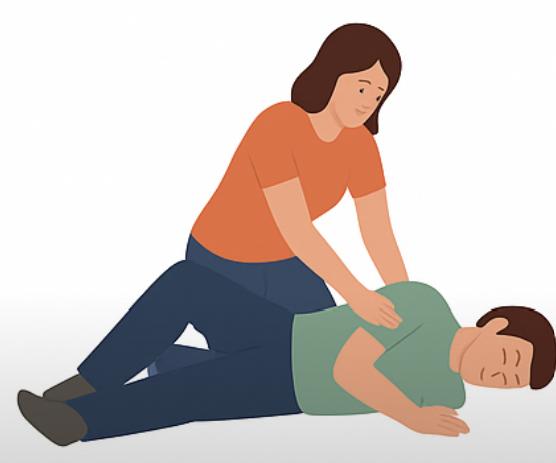The Recovery Position
The Recovery Position: A Prehospital Essential
The recovery position (also called the lateral or semi-prone position) is a safe way to place an unconscious but breathing patient. It helps maintain airway patency, reduces the risk of aspiration of vomit or secretions, and provides a stable posture until further care arrives.
It is recommended by the NHS, Resuscitation Council UK, and first aid organisations including St John Ambulance and the British Red Cross.
Indications & Contraindications For Recovery Position
✅Use the recovery position when:
-
The patient is unresponsive but breathing normally.
-
You need to protect the airway and allow drainage of fluids.
-
You want to keep your hands free to summon help or manage other patients.
❌Avoid or adapt the recovery position if:
-
The patient is not breathing normally, begin CPR instead.
-
There is a suspected spinal injury, maintain airway with manual techniques rather than rolling.
-
The patient is an infant, use infant-specific positioning instead.
Step-By-Step Guide
Check for danager
Assess responsiveness and breathing
Remove glasses and clear nearby hazards
Place the arm nearest you at a right angle, elbow bent, palm up.
Take the far arm, bring it across the chest, and rest the back of the hand against the cheek nearest you.
Bend the far knee so the foot is flat on the floor.
Use the bent knee as a lever to gently roll the patient toward you.
Tilt the head back slightly to open the airway.
Keep the top leg bent at a right angle to stabilise the body.
Continue to monitor breathing and pulse.
Images from: The recovery position | Epilepsy Society
Evidence and Clinical Relevance
While the recovery position may feel “basic,” studies show it is highly effective:
Paediatric data suggest children placed in the recovery position after reduced responsiveness were less likely to require hospital admission (Eich et al., 2009).
In adult poisoning cases, semi-prone positions reduced aspiration compared with supine (Hall et al., 2008).
International resuscitation guidelines consistently emphasise lateral positioning as the safest option for an unconscious, breathing patient.
The Recovery Position Video
I-Gel Key Points
-
Use the recovery position for any unconscious but breathing patient without suspected spinal injury.
-
It is a low-tech, high-impact intervention that can be delivered by both trained clinicians and bystanders.
-
In seizure management, it protects the airway during recovery.
-
Even in an era of advanced prehospital equipment, this simple manual skill continues to save lives daily.

Bibliography
British Red Cross. (n.d.). Unresponsive and breathing. British Red Cross. https://www.redcross.org.uk/first-aid/learn-first-aid/unresponsive-and-breathing
Eich, C., Roessler, M., Nemeth, M., Russo, S. G., Heuer, J. F., & Timmermann, A. (2009). Characteristics and outcome of patients in the recovery position after prehospital emergency ventilation. Resuscitation, 80(12), 1373–1377. https://doi.org/10.1016/j.resuscitation.2009.09.014
Epilepsy Society. (2025). First aid for epileptic seizures: Recovery position. Epilepsy Society. https://epilepsysociety.org.uk/about-epilepsy/first-aid-epileptic-seizures/recovery-position
Geeky Medics. (2025). Recovery position OSCE guide. Geeky Medics. https://geekymedics.com/recovery-position-osce-guide/
Hall, A. H., Smolinske, S. C., & Conrad, F. L. (2008). Positioning for aspiration prevention in acute poisoning: Prone, semiprone, and lateral recumbent positions. Journal of Toxicology: Clinical Toxicology, 46(9), 989–992. https://doi.org/10.1080/15563650802424634
National Health Service. (2024). How to put someone in the recovery position. NHS. https://www.nhs.uk/tests-and-treatments/first-aid/recovery-position/
Resuscitation Council UK. (2021). Adult basic life support guidelines. Resuscitation Council UK. https://www.resus.org.uk/library/2021-resuscitation-guidelines/adult-basic-life-support
St John Ambulance. (n.d.). How to put someone in the recovery position. St John Ambulance. https://www.sja.org.uk/first-aid-advice/recovery-position/
Vanpee, D., Swine, C., & Lamy, M. (2002). The recovery position: What is the evidence? Resuscitation, 53(3), 289–296. https://doi.org/10.1016/S0300-9572(02)00038-6











